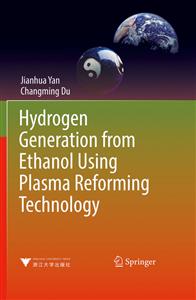扫一扫
关注中图网
官方微博
本类五星书更多>
-
>
湖南省志(1978-2002)?铁路志
-
>
公路车宝典(ZINN的公路车维修与保养秘籍)
-
>
晶体管电路设计(下)
-
>
基于个性化设计策略的智能交通系统关键技术
-
>
德国克虏伯与晚清火:贸易与仿制模式下的技术转移
-
>
花样百出:贵州少数民族图案填色
-
>
识木:全球220种木材图鉴
等离子体重整乙醇制氢技术——英文 版权信息
- ISBN:9787308187664
- 条形码:9787308187664 ; 978-7-308-18766-4
- 装帧:一般轻型纸
- 册数:暂无
- 重量:暂无
- 所属分类:>
等离子体重整乙醇制氢技术——英文 内容简介
本书对采用等离子体或等离子体—催化工艺重整诸如乙醇等可再生原料制氢的研究进行了介绍。利用新型等离子体工艺及等离子体催化联合工艺可减少氮氧化物排放,且能量循环中减少“碳迹”,因而在再生资源制氢领域上表现出了强大的潜力。实验结果表明将等离子体与催化工艺相结合可产生协同作用。本书介绍了输入功率、反应器结构、反应温度、载气类型及原料组分等影响因素对重整效率的影响。为进一步了解和评估重整效率,本书还对乙醇重整的多种模型进行介绍,比较了不同等离子体反应器重整乙醇的效果,并从各等离子体类型的特征对其进行具体分析。本书在*后展望了未来该领域可能的研究发展方向,并预测了新一代燃料制氢工艺的发展及趋势。
等离子体重整乙醇制氢技术——英文 目录
1 Plasma for Ethanol Reforming
1.1 Hydrogen and Plasma
1.2 Reforming Technologies of Liquid Fuel
1.2.1 CO2 Reforming
1.2.2 Partial Oxidation Reforming
1.2.3 Steam Reforming
1.2.4 Autothermal Reforming
1.2.5 Comparison Among Different Reforming Processes
1.3 Hydrogen Production by Ethanol Reforming
1.3.1 Catalytic Ethanol Reforming for Hydrogen Production
1.3.2 Plasma Ethanol Reforming for Hydrogen Production
References
Non-thermal Are Plasma for Ethanol Reforming
and Hydrogen Production
2.1 Non-thermal Plasma
2.2 Non-thermal Arc Plasma Reforming of Ethanol to Produce
Hydrogen
2.3 Factors Affecting on Plasma Reforming of Ethanol
2.3.1 Effects of the Components of the Materials
2.3.2 Effects of the Carrier Gas
2.3.3 Effects of the Input Power
2.3.4 Effects of Other Factors
2.4 Comparison of the Non-thermal Plasma Reforming of Ethanol
2.5 Developmental Trends of the Non-thermal Arc Plasma
Reforming of Ethanol
References
3 Hydrogen from Ethanol by a Plasma Reforming System
3.1 Introduction
3.2 Materials and Methods
3.2.1 Experimental Setup
3.2.2 Calculation
3.3 Results and Discussion
3.3.1 Effect of the O/C Ratio
3.3.2 Effect of the S/C Ratio
3.3.3 Effect of the Input Power
3.3.4 Effect of the Ethanol Flow Rate
3.4 Conclusion
References
4 Hydrogen from Ethanol by a Miniaturized Plasma
Reforming System
4.1 Introduction
4.2 Experimental Setup
4.3 Results and Discussion
4.3.1 Voltage-Current Characteristic
4.3.2 Effect of the O/C Ratio
4.3.3 Effect of the S/C Ratio
4.3.4 Effect of the Ethanol Flow Rate
4.4 Conclusion
References
Plasma-Catalytic Reforming for Hydrogen Generation
from Ethanol
5.1 Introduction
5.2 Experimental Setup
5.2.1 Plasma-Catalytic Setup
5.2.2 Catalysts Characterization
5.3 Results and Discussion
5.3.1 Effect of the O/C Ratio
5.3.2 Effect of the S/C Ratio
5.4 Conclusion
References
6 Mechanism for the Plasma Reforming of Ethanol
6.1 Mechanism Analysis of the Single Plasma Reforming of Ethanol
6.1.1 Electron-Molecule Collision
6.1.2 Free Radical Reaction
6.1.3 The Generation and Conversion of the Main Products
6.1.4 Suppression and Removal of Carbon Deposition
in the Reforming Process
6.1.5 Removal of NOr in the Process of Reforming
6.2 Mechanism Analysis of the Plasma-Catalytic Reforming
of Ethanol
6.2.1 Related Mechanism of the Catalytic Reforming
of Ethanol
6.2.2 Effects of Plasma on the Surface Characteristics
of the Catalyst
6.2.3 The Surface Reaction of the Electronic/Radical-Catalyst
6.3 Comparison Between Plasma Reforming and
Plasma-Catalyst Reforming
6.4 Summary
References
7 Outlook
Index
1.1 Hydrogen and Plasma
1.2 Reforming Technologies of Liquid Fuel
1.2.1 CO2 Reforming
1.2.2 Partial Oxidation Reforming
1.2.3 Steam Reforming
1.2.4 Autothermal Reforming
1.2.5 Comparison Among Different Reforming Processes
1.3 Hydrogen Production by Ethanol Reforming
1.3.1 Catalytic Ethanol Reforming for Hydrogen Production
1.3.2 Plasma Ethanol Reforming for Hydrogen Production
References
Non-thermal Are Plasma for Ethanol Reforming
and Hydrogen Production
2.1 Non-thermal Plasma
2.2 Non-thermal Arc Plasma Reforming of Ethanol to Produce
Hydrogen
2.3 Factors Affecting on Plasma Reforming of Ethanol
2.3.1 Effects of the Components of the Materials
2.3.2 Effects of the Carrier Gas
2.3.3 Effects of the Input Power
2.3.4 Effects of Other Factors
2.4 Comparison of the Non-thermal Plasma Reforming of Ethanol
2.5 Developmental Trends of the Non-thermal Arc Plasma
Reforming of Ethanol
References
3 Hydrogen from Ethanol by a Plasma Reforming System
3.1 Introduction
3.2 Materials and Methods
3.2.1 Experimental Setup
3.2.2 Calculation
3.3 Results and Discussion
3.3.1 Effect of the O/C Ratio
3.3.2 Effect of the S/C Ratio
3.3.3 Effect of the Input Power
3.3.4 Effect of the Ethanol Flow Rate
3.4 Conclusion
References
4 Hydrogen from Ethanol by a Miniaturized Plasma
Reforming System
4.1 Introduction
4.2 Experimental Setup
4.3 Results and Discussion
4.3.1 Voltage-Current Characteristic
4.3.2 Effect of the O/C Ratio
4.3.3 Effect of the S/C Ratio
4.3.4 Effect of the Ethanol Flow Rate
4.4 Conclusion
References
Plasma-Catalytic Reforming for Hydrogen Generation
from Ethanol
5.1 Introduction
5.2 Experimental Setup
5.2.1 Plasma-Catalytic Setup
5.2.2 Catalysts Characterization
5.3 Results and Discussion
5.3.1 Effect of the O/C Ratio
5.3.2 Effect of the S/C Ratio
5.4 Conclusion
References
6 Mechanism for the Plasma Reforming of Ethanol
6.1 Mechanism Analysis of the Single Plasma Reforming of Ethanol
6.1.1 Electron-Molecule Collision
6.1.2 Free Radical Reaction
6.1.3 The Generation and Conversion of the Main Products
6.1.4 Suppression and Removal of Carbon Deposition
in the Reforming Process
6.1.5 Removal of NOr in the Process of Reforming
6.2 Mechanism Analysis of the Plasma-Catalytic Reforming
of Ethanol
6.2.1 Related Mechanism of the Catalytic Reforming
of Ethanol
6.2.2 Effects of Plasma on the Surface Characteristics
of the Catalyst
6.2.3 The Surface Reaction of the Electronic/Radical-Catalyst
6.3 Comparison Between Plasma Reforming and
Plasma-Catalyst Reforming
6.4 Summary
References
7 Outlook
Index
展开全部
书友推荐
- >
自卑与超越
自卑与超越
¥14.7¥39.8 - >
经典常谈
经典常谈
¥12.7¥39.8 - >
新文学天穹两巨星--鲁迅与胡适/红烛学术丛书(红烛学术丛书)
新文学天穹两巨星--鲁迅与胡适/红烛学术丛书(红烛学术丛书)
¥9.9¥23.0 - >
中国历史的瞬间
中国历史的瞬间
¥16.7¥38.0 - >
上帝之肋:男人的真实旅程
上帝之肋:男人的真实旅程
¥19.3¥35.0 - >
企鹅口袋书系列·伟大的思想20:论自然选择(英汉双语)
企鹅口袋书系列·伟大的思想20:论自然选择(英汉双语)
¥6.3¥14.0 - >
唐代进士录
唐代进士录
¥15.1¥39.8 - >
随园食单
随园食单
¥15.4¥48.0



















